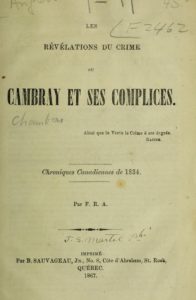CHAMBERS, Charles (ca 1812 – 1837)
Biography
Charles Chambers was born around 1812, probably in the Montreal area, the son of Frederick Chambers, a shoemaker, and Marie Wagner, possibly of German origin. He was likely an Anglican. Contrary to what some authors assert, he was probably not related to Robert Chambers, future mayor of Quebec City.
Chambers was a carpenter and joiner, and a sometime a wood trader. He nevertheless seems to have been fairly well educated, judging by his signature. In 1834, at Quebec City, he married Julie Gagné, daughter of Joseph Gagné, a butcher; she died in 1836.
By the early 1830s, Chambers was well-known to the authorities, due to his involvement in various minor crimes. By the mid-1830s, he was the head of a small group of criminals, the “Chambers Gang”, which carried out a number of spectacular thefts in the Quebec City region, terrifying the population. During one burglary in Lotbinière, the victim, Louis Sivrac, was killed; at another point, the gang even robbed the chapel of the Congregation in Quebec City (currently the Jesuit chapel).
In 1835, Chambers was arrested and locked up in Quebec City’s common gaol, facing four different charges. He managed to avoid conviction on all four and was released. The following year, he was arrested again, along with his accomplice Nicolas Mathieu, for burglarizing the house of Mary Ross, widow Montgomery. This time, another of Chambers’ former accomplices testified against them, and they were found guilty. Following the criminal law then in force, Chief Justice Jonathan Sewell had no choice but to sentence them to death. As was usual in such cases, Chambers and Mathieu both got up petitions begging governor Gosford to pardon them. After his conviction, Chambers apparently feigned conversion to Catholicism. His pardon petition was thus signed by dozens of French-speaking Catholic residents of Quebec City, along with several members of the clergy, including Charles Chiniquy, the future temperance crusader. Following a favourable recommendation from the colony’s Executive Council, Gosford commuted sentences of the two to life in exile in one of the penal colonies in Australia.
Chambers left Quebec City for England in May 1837, on board the ship Ceres, on the first leg of his trip to Australia. But he never made it to the penal colony; he died in Woolwich, England, on November 14 1837, while waiting for the second leg of his trip into exile.
The exploits of Chambers and his gang were immortalized by François-Réal Angers in a sensationalist, semi-fictionalized text, Les révélations du crime ou Cambray et ses complices, published a few months after Chambers’ departure. The book was a success and was reprinted at least twice, in 1867 and in 1880. Chambers and his gang thus entered the pantheon of Quebec criminals. Their legend grew over the years, with more and more crimes attributed to them, including murders in which they were not at all involved. Still, even without the embroidery, the facts of Chambers’ life make him an extraordinary figure in Quebec history.
– Donald Fyson, June 2015
Images
Bibliography
Primary sources
- Angers, F.R. Les révélations du crime ou Cambray et ses complices: chroniques canadiennes de 1834. Québec: Fréchette, 1837. <https://archive.org/details/cihm_21603>
- Bibliothèque et Archives nationales du Québec, «Le fichier des prisonniers des prisons de Québec au 19e siècle», <http://www.banq.qc.ca/archives/genealogie_histoire_familiale/ressources/bd/instr_prisons/prisonniers/index.html> (transcription of the Quebec common gaol registers, the originals of which are in Bibliothèque et Archives nationales du Québec, Centre de Québec, E17,S1).
- Bibliothèque et Archives nationales du Québec, “Documents judiciaires concernant Charles Chambers et Nicolas Mathieu”, P1000,S3,D2217. <http://pistard.banq.qc.ca:7777/unite_chercheurs/description_fonds?p_anqsid=20150526082934330&p_centre=03Q&p_classe=P&p_fonds=1000&p_numunide=3879>
- Library and Archives Canada, RG4 A1, vol. 506 and 508; RG4 B20, vol. 20. p. 8730-8756.
- Quebec Mercury, 28 March, 30 March, 1 April and 11 April 1837. <http://collections.banq.qc.ca/ark:/52327/1875218>
Secondary sources
- Angers, F. Réal. Les révélations du crime ou Cambray et ses complices: chroniques canadiennes de 1834. Introduction and bibliography by Gilles Dorion. Québec: Nota bene, 2003.
- Cambron, Micheline. “Vous avez dit roman? Hybridité générique de nos “premiers romans”, L’influence d’un livre et Les révélations du crime“. Voix et Images 32(3)(2007): 43-57.
- Fyson, Donald. “Prison Reform and Prison Society: The Quebec Gaol, 1812-1867”. In Louisa Blair, Patrick Donovan and Donald Fyson, From Iron Bars to Bookshelves: A History of the Morrin Centre (Montreal: Baraka Books, forthcoming).
- Lapointe, Vicky. “La petite histoire du crime: la bande à Chambers” (2010). Six-part blog posting with varying titles, the first of which is at <https://tolkien2008.wordpress.com/2010/04/28/la-petite-histoire-du-crime-la-bande-a-chambers-quebec-et-sa-region-1831-1835/>.
- Roy, Pierre-Georges. Les petites choses de notre histoire. Septième série. Lévis: Éditions Garneau, 1944. <http://www.ourroots.ca/toc.aspx?id=3323>

